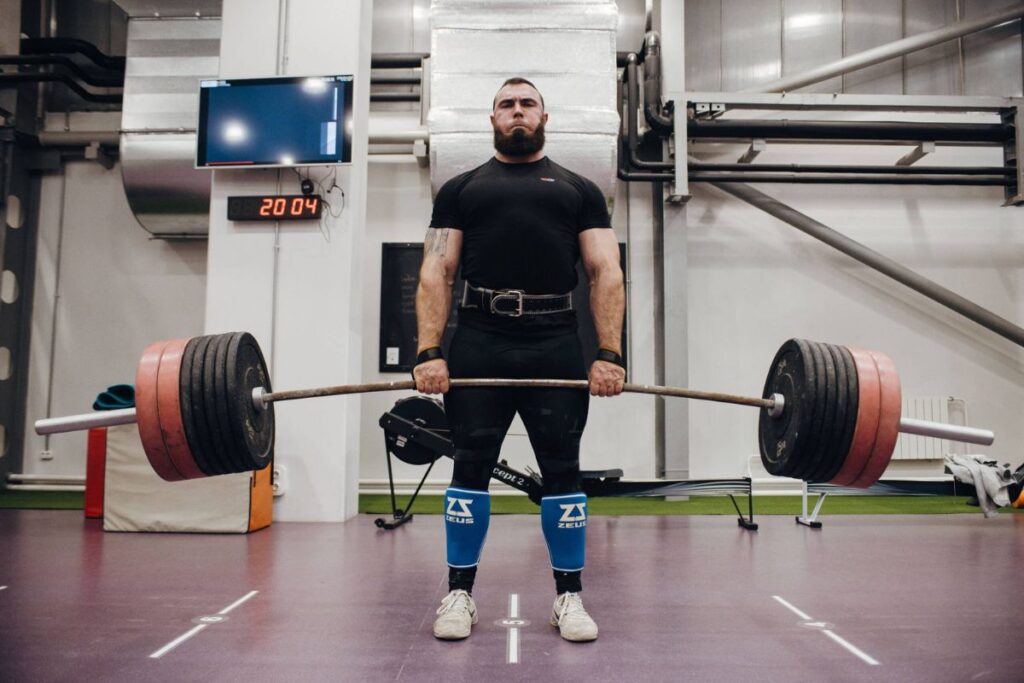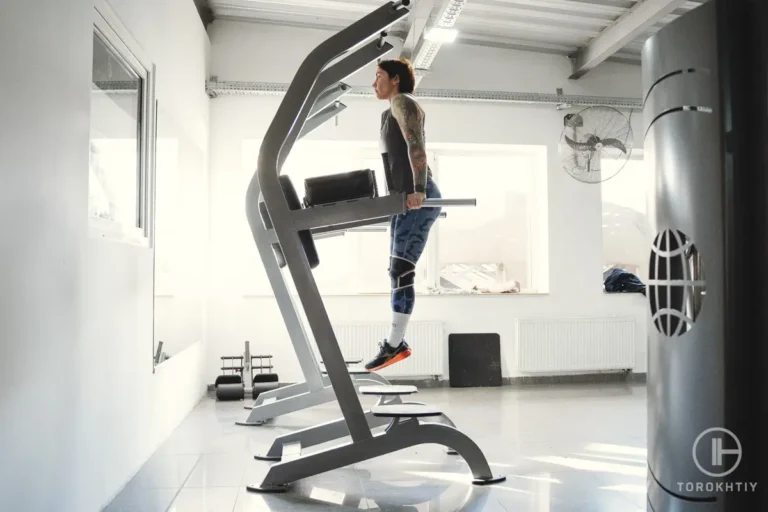How To Keep Back Straight During A Deadlift?
No matter which workout routine you follow, the deadlift is bound to be one of the staple exercises of the routine. It targets a large chunk of the back muscles and is considered one of the four most important lifts, but do you know how to keep back straight deadlifting weight? Are you getting the maximum performance?
How to keep back straight deadlift? The most important thing to keeping your back straight is engaging your core. The core muscles control stability. Additionally, you need to have a proper setup. The setup is responsible for maintaining the integrity of your spine.
Sounds complicated, right?
Don’t worry, I got you covered and the article will teach you the importance of the straight back deadlift, and how to avoid lower back rounding during deadlift exercises. Once you have read this article, you should know how to keep back straight when deadlifting and sorting out any frustrating issues that could frustrate your lifting or strength capabilities.

Why Is It Important To Keep Your Back Straight During The Deadlift?
Your spine is one of the most essential parts of your body. The spine keeps us upright, whilst connecting different parts of the skeleton. Even though the spine is made up of various bones, it contains numerous elastic ligaments and spinal disks that allow the spine to flex.
The most important reason for keeping the spine straight and using a neutral posture for deadlifting is to prevent possible injury to the spine.
Once you suffer from spinal injuries, it will impede a large chunk of your daily activities. Yes, you might be able to lift more with a rounded back, but the risks are high and could lead to permanent injury and back problems if you use a weight that is too heavy.

What Back Position During The Deadlift Can Be Dangerous And Incorrect?
One of the first steps to correcting your deadlift is to have a look at your current form. Certain forms and positions could be dangerous and incorrect. Before we look at how to correct these specific forms, you should understand how not to do it and why. Here are a few deadlift forms that could be dangerous and incorrect.
1. Scared Cat Deadlift / Cat Back Deadlift
Have you ever noticed how a frightened cat changes their body when they get scared? They often lift their back with their hair raised, making themselves as tall as possible. This is called the “scared cat deadlift” or “rounding of the back”.
The cat back deadlift is characterized by an improper curvature in the thoracic and lumbar portions of the spinal column.
The issue with this movement is that there is a lot of pressure placed on the spine in this non-neutral curved position. It could lead to some of the following:
- Slipping of the spinal discs
- Compressed spinal discs
- Fused spinal discs
- Pinched nerves
- Compressed nerves
- Soft tissue injuries in the lower and middle back
It is easy to see if you are making this mistake and you will find that your spine is rounded and your butt is pushed in. Simply imagine a cat being frightened when watching yourself in the mirror to identify this issue.

2. Using Of The Biceps To Lift
If you have the spinal position sorted, but you are bending your arms, or using the underhanded grip too frequently, you are putting plenty of strain on the bicep muscles. The biceps brachii should only act as a stabilizer to keep the bar in the correct position.
However, some lifters often recruit the biceps as part of the lifting motion and this puts all the weight of the deadlift bar on the biceps. It is best to use the underhanded grip for lighter weights, whilst using the overhand or mixed grip for heavier lifts. The arms should remain fully extended below the torso whilst performing the movement.
3. Knee Valgus / Knees Collapsing Inwards
The deadlift workout is best described as a full-body workout that targets a large chunk of the muscles. However, some lifters suffer from “Knee Valgus”, which refers to the knees collapsing inwards. It occurs most frequently during the initial stages of the lift and can lead to serious injury.
Injuries to the quadriceps like tendinopathy can be a major risk. Additionally, the knee tissue would be in the firing line, which could also do some soft-tissue damage.
4. Starting With Legs Fully Extended
Another issue we often see from beginners is starting the motion with their legs fully extended. The fully extended legs might seem like you are performing the flat back deadlift when looking in the mirror. However, once the person lifts the weight, forces are pulling in opposite directions.
You have your weight pulling you down onto your legs, and the weight from the bar in your hands pulling you forward and down at a different leverage point. This often leads to the backing rounding and you will find yourself in the scared cat deadlift position.
The same injuries that could happen when performing a deadlift with a rounded back could also occur when you start with the legs locked or extended and the hips too high.

Why Does My Back Round When I Deadlift?
Not that you have seen some of the possible injuries and risks you could face from an incorrect deadlift form, but we need to figure out why it happens. The rounded back issue is the most common, and no matter when you go to the gym, you ought to see at least one person doing it with a rounded back. However, let’s look at why this happens.
1. Poor Glute Strength And Hamstring Flexibility
The first issue often happens in the legs. Since the person cannot comfortably flex their hamstrings, they are more inclined to keep them locked in place. This lack of hamstring flexibility forces their legs straight and rounds the back.
If the lifter is overloading the weight on the bar and they struggle with glute strength, the arms need to take over. During this process, you are pulled down at two different points. To lift the weight, more force is needed, which is only achievable by arching the back.
2. Lack Of Core Stability
Whilst some lifters round their back when they are lifting light weights, others only round their backs when lifting heavy weights.
The main reason for this is due to the core, lacking the strength and stability to stabilize the spine in a flat position. A lack of hip mobility can also play a role in arching the back when you are lifting the weight.
3. Weight Is Too Heavy
To tie these two points together, it all comes down to the weight you are lifting. If the weight is too heavy, you are bound to bend your back more. Whilst this is fine for the experienced lifters aiming for world records and 1-rep max lifts, the standard lifter does not have the technique and it is mostly due to bad core strength, poor glute strength, and a lack of hamstring flexibility that causes the rounding motion.

How To Keep Your Back Straight In A Deadlift?
With all the possible causes and issues from the causes out of the way, we should look at how to keep back straight during deadlift exercises. The straight back deadlift is highly functional and would allow you to get an efficient workout. Here is how to ensure that lower back rounding during deadlift exercises is a thing of the past:
1. The Setup
It is important to set up the weight so that you are comfortable lifting. This means not going too heavy, but focusing on the correct form.
Once you have the weight set up, you should approach the bar with your feet about hip-width apart. Once you slide your feet under the bar, it should be over the middle of the foot and could even touch the shins.
2. Grabbing The Bar
Once you are in the right position after the setup, you will need to bend over and grab the bar with both hands. Here, you can choose to use the double-overhand grip, which we recommend for beginners, or the alternating grip (One hand over, and the other hand under).
Your arms should be outside of your knees, or slightly wider than your knees when you take up this position.

3. Gearing Up For The Lift (Lifter’s Wedge)
Many experts refer to the moment before you lift as finding the “lifter’s wedge”. During this process, you flatten your back by pushing out the butt and looking up straight with your chin up. Your shoulders should be pulled back towards your pockets and you can pull on the bar to get some of the slack out of your arms.
You will sit your hips down during the process and pull your chest up. Many experts recommend that you find something to stare at about 10 feet in front of you.
In this position, you should start to feel the tension and your lats should squeeze, while your core is tightening up. At this point, you are squeezing the bar with your hands and a slight stretch should occur in the hamstrings.
4. The Lift
The actual lift is the most important part of the process. Now that you are in the correct position, you should pull the bar straight up. You can imagine the bar being on rails and it should come up straight instead of swinging like a pendulum.
Whilst lifting, your glutes and hamstrings will come up and straighten to keep the bar coming up straight. Once the bar travels up past your knees, you can pull the bar into your hips. The main goal is to ensure the bar remains as close to your body as possible until you reach an upright position.
5. Lowering The Bar
Unless you are doing a 1 rep max lift, you do not need to drop the bar to the floor. You should slowly bend your waist, whilst keeping the bar as close to your body as possible. Once the bar clears your kneecaps, you can bend your knees to finish the movement.
If the bar is on the ground, you should take a few deep breaths, before repeating the same process to perform the next repetition.
Top 3 Exercises For Straight Back Deadlift
By now, we have established the reason for the arching back is often due to some form of weakness in the muscles used. To perfect your deadlift, you should focus on training these muscles. By strengthening them, you ought to be able to perform the neutral spine deadlift more efficiently. Here are a few good exercises to consider:
1. Paused Deadlift
The paused deadlift is one of the best ways to be in a deadlift position and train your deadlifting muscles. You will choose a challenging weight and set it up in the deadlift position. However, you should pause for three seconds once you lift the bar off the ground. This allows you to quickly assess if your back is flat. Using a mirror in front of you can help you see this.
2. Hyper Extensions
The traditional hyper extension is a great way to train your back. You will need a hyper extension machine. Once in the machine, you should focus on keeping your back straight whilst pivoting up and down. As you increase your lower back strength, you can add weight as well. This would eliminate lower back rounding during deadlift exercises.
3. Good Mornings
Good mornings are a standing variation of the hyper extension workout. During the workout, you will use a weighted bar and place it on your neck like you would perform a squat. However, your legs should remain in position and only have a slight bend. You will need to keep your back straight as you pivot down and back up, strengthening the lower back and the hamstrings.
🔻12-Week Deadlift Strength Program by Oleksiy Torokhtiy
Unlock your true potential with our Deadlift Strength Program!
Designed for athletes by 2-time Olympian Oleksiy Torokhtiy, this 12-week program focuses on enhancing your deadlift strength, strengthening your back and legs.
Program details:
- 12 weeks;
- 3 days / week;
- 45-120 minutes per session;
- 50+ specific exercises;
- Focus on New Result in Deadlift;
- One-time payment, no recuring payments;
- Full access to all training content.
Start now and boost your deadlift results!
FAQ
Why Can’t I Keep My Back Straight When Deadlifting?
There are two main reasons for individuals struggling to keep their back straight during a deadlift. The most common is using a weight that is too heavy. Even the top powerlifters often use this during their competitions.
The other reason is not having enough hamstring flexibility or glute strength to perform the deadlift. These can be trained using the above-mentioned exercises.
Why Does My Back Curve When I Deadlift?
Your back would naturally curve when you are lifting a weight that is too heavy. However, not setting yourself up in a stable position or performing the correct motion could pull you in two different directions. This is often why you can’t keep back straight during deadlift.
How To Keep Back Straight During RDL?
When it comes to the Romanian Deadlift, one of the main reasons that people bend their backs is due to not pushing their hips back. Instead of bending over, you should push your hips back, which naturally pulls you down. When lifting the bar, your hips should come forward in a thrusting motion, forcing you to stand upright.
Conclusion
Performing deadlifts is an essential part of working out. Most workout programs would have at least one form of the deadlift unless you have serious lower back issues. These should help you master the deadlift and ensure that you have the perfect motion. Let us know in the comment section if you have managed to perfect your deadlift.
Also read:
- Deadlift Accessory Exercises
- Deadlift Cues
- High Rep Deadlifts
- Are Deadlifts Good for Abs
- Deadlift Progress
- Is 405 a Good Deadlift
References:
- How Does the Spine Work? // NCBI: https://www.ncbi.nlm.nih.gov/books/NBK279468/
- Physical Activity and Quality of Life in Adults With Spinal Cord Injury // NCBI: https://www.ncbi.nlm.nih.gov/pmc/articles/PMC2582427/
- Thoracolumbar And Lumbopelvic Spinal Alignment During The Deadlift Exercise // NCBI: https://www.ncbi.nlm.nih.gov/pmc/articles/PMC9528690/
- Deadlift Exercise // PhysioPedia: https://www.physio-pedia.com/Deadlift_Exercise
- The Truth About Lower Back Pain After Deadlift // LiftPhysio: https://www.liftphysio.com.au/blog/lifting-and-lower-back-pain
- Towards evidence based strength training // NCBI: https://www.ncbi.nlm.nih.gov/pmc/articles/PMC5513080/
- The Deadlift and Its Application to Overall Performance // NSCA: https://www.nsca.com/education/articles/tsac-report/the-deadlift-and-its-application-to-overall-performance/
Why Trust Us?
With over 20 years in Olympic Weightlifting, our team does its best to provide the audience with ultimate support and meet the needs and requirements of advanced athletes and professional lifters, as well as people who strive to open new opportunities and develop their physical capabilities with us.
By trusting the recommendations of our certified experts in coaching, nutrition, dietology, and sports training programming, as well as scientific consultants, and physiotherapists, we provide you with thorough, well-considered, and scientifically proven content. All the information given in the articles concerning workout programming, separate exercises, and athletic performance, in general, is based on verified data. We ensure that you can rely on our professionals’ pieces of advice and recommendations that can be treated as personalized ones which will benefit you and fully meet your needs.
The product testing process is described in more detail here
Author: Sergii Putsov
Head of Sport Science, PhD
Best Results: Snatch – 165 kg,
C&J – 200 kg
Sergii Putsov, Ph.D., is a former professional weightlifter and National team member, achieving multiple medals in the 94 kg weight category at national competitions. With a Master’s degree in “Olympic & Professional Sport Training” and a Sport Science Ph.D. from the International Olympic Academy, Greece, Sergii now leads as the Head of Sport Science. He specializes in designing training programs, writing insightful blog articles, providing live commentary at international weightlifting events, and conducting educational seminars worldwide alongside Olympic weightlifting expert Oleksiy Torokhtiy.








